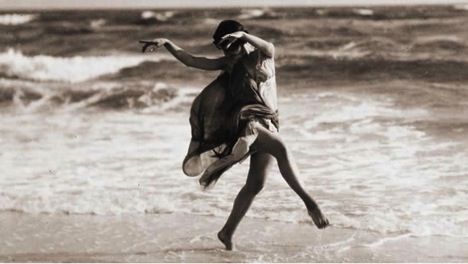[12] An “Isadorable” Dancing in the Swash

The school of the ballet of today, vainly striving against the natural laws of
gravitation or the natural will of the individual, and working in discord in its form
and movement with the form and movement of nature, produces a sterile movement which
gives no birth to
future movements, but dies as it is made.
—Isadora Duncan2
1
The formalities of ballet, those forms and poses and steps, so like an alphabet for writing only one kind of story; they stick sometimes in the throat of a restless dancer. She feels bound around with ropes and chains, she can’t find her breath, and when she has performed a perfect arabesque it seems as if she had just been reciting old familiar phrases, stale and dull. Oh, another might say to her that it was perfect! But that’s just it, it’s always perfect, but where’s the risk, the adventure, and sense of novelty? If you know what’s coming next, it tends to put you to sleep. The poet who counts the stresses per line, who rhymes dance with romance, and fits himself into the counted regularities of the sestina, fulfills the form, perhaps to perfection, but it is still only a form, like a triangle or circle, where knowing one or two parts, we then know all the rest. Who wouldn’t want to step right out of the middle of that double cabriole, and follow the arc of a deceiving elbow or ankle, wherever it goes?
his modern dancer
reins in her formalism
slides from her penché
twirls, curling up, and crouches
like a turbulent tiger
wild leaping salmon
going up the weir at Slane
push back on the Boyne—
here’s one flying high; he twists
to a silver torpedo
a hurried plover
running bourrée over wetted sand
mad for tiny crabs
swerves first this way, and then that
in his choreography
2
Charles Olson wrote in his essay “Projective Verse” that the poetry of the future must follow no prescription “other than the one the poem under hand declares, for itself,” and that that must be in the words as they are measured by the breath, and in a form that sticks to the subject at hand. No more jamming thoughts and feelings into ready-made structures. And the writing principle is that no idea leads to anything but another and further idea. There is no looking back. In this vein, the dance, danced freely, leaps from one exhalation to another, as fast as the dancer’s imagination (feeling) and feet can provide them. Each step sets up the next. The dancer-artist-poet finds that next move, the one that the preceding move requires, and from there goes on to the next, with no prior assumptions, certainly no formal story. Pound’s lines in The Cantos spell out how, “in the west mountain, Il Fiorentino,/ Seeing hell in his mirror,” and then shift quickly away to: “lo Sordels/ Looking on it in his shield;/ And Augustine, gazing toward the invisible.” The dancers run and leap and run...O, follow it if you can!
does she know which leap
will be coming next? Will she
pirouette saltily
there in the sea, imagining
her companions in the surf
each dance step gauche
like a toddler’s learning to walk
an aspiration
calling forth, carrying on
the dance of conceiving itself
a fact about rhythm
how melody and feelings
mix in the program
what an elevated kick!
follow it with something low
3
The dancer skipping her complicated poetry in kicks, jumps, and poses in shallow water along the beach, her splashing counting, for some, as expression—but expression of what? Consider the arbitrary marks we think we understand, like the printed Alphabet, the semaphore signal for E or 5, the letters and numerals in the Periodic Table, the International Phonetic Alphabet, or what is more to the subject here, complicated dance steps represented in any of the dance notation systems that have been available for centuries. Imagine sketches or stick-figures showing legs or arms rising and falling, a reversal left-for-right, inscribed along a parallel musical score. As your eyes follow the dancer now in the sea, rising and falling, cavorting in the waves, imagine a little man behind her in the water with a megaphone calling out to another man up on the sand a succession of numbers or odd names of steps and gestures. See the man up on the sand writing furiously on his clipboard—will anyone ever remember? Go slower! What was she trying to exhibit as she leapt and sprang (was there something crucial just before she raised her right leg and both arms up in front of her?); what, in her heart, was that movement satisfying, as the moment itself rushed past?
there’s a thing we do
when we dance. are we finding
possibilities
in the movement of our limbs?
are we imitating flight?
Yvonne de Carlo
hardening country bumpkins
as Salome, where
she danced, lithe as a cobra
Lester Horton’s magic moves
or is it movement
to no purpose? pointless leaps
savoring weightless
intoxications beyond
the sodden pull of gravity
Bio: Charles D. Tarlton
